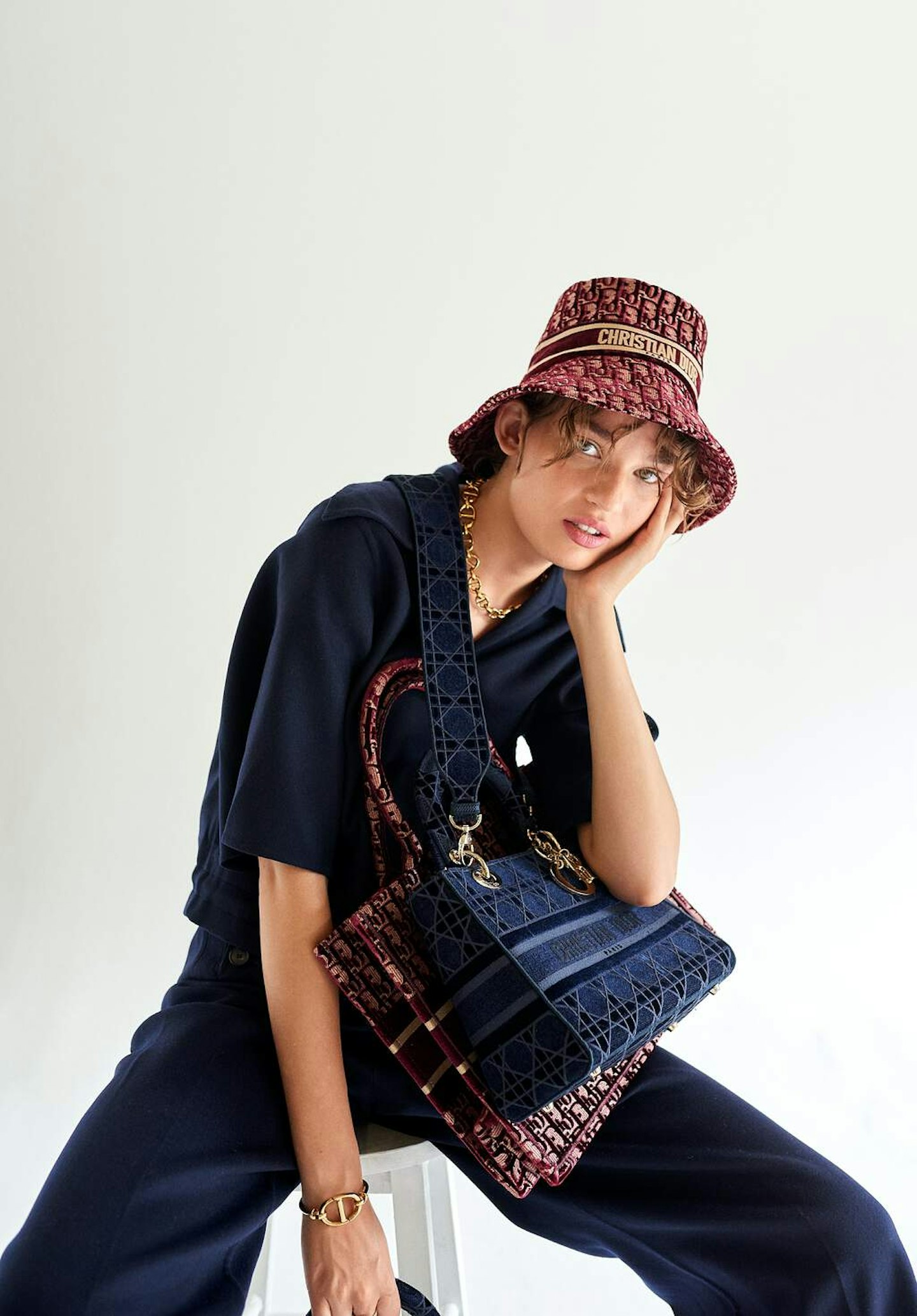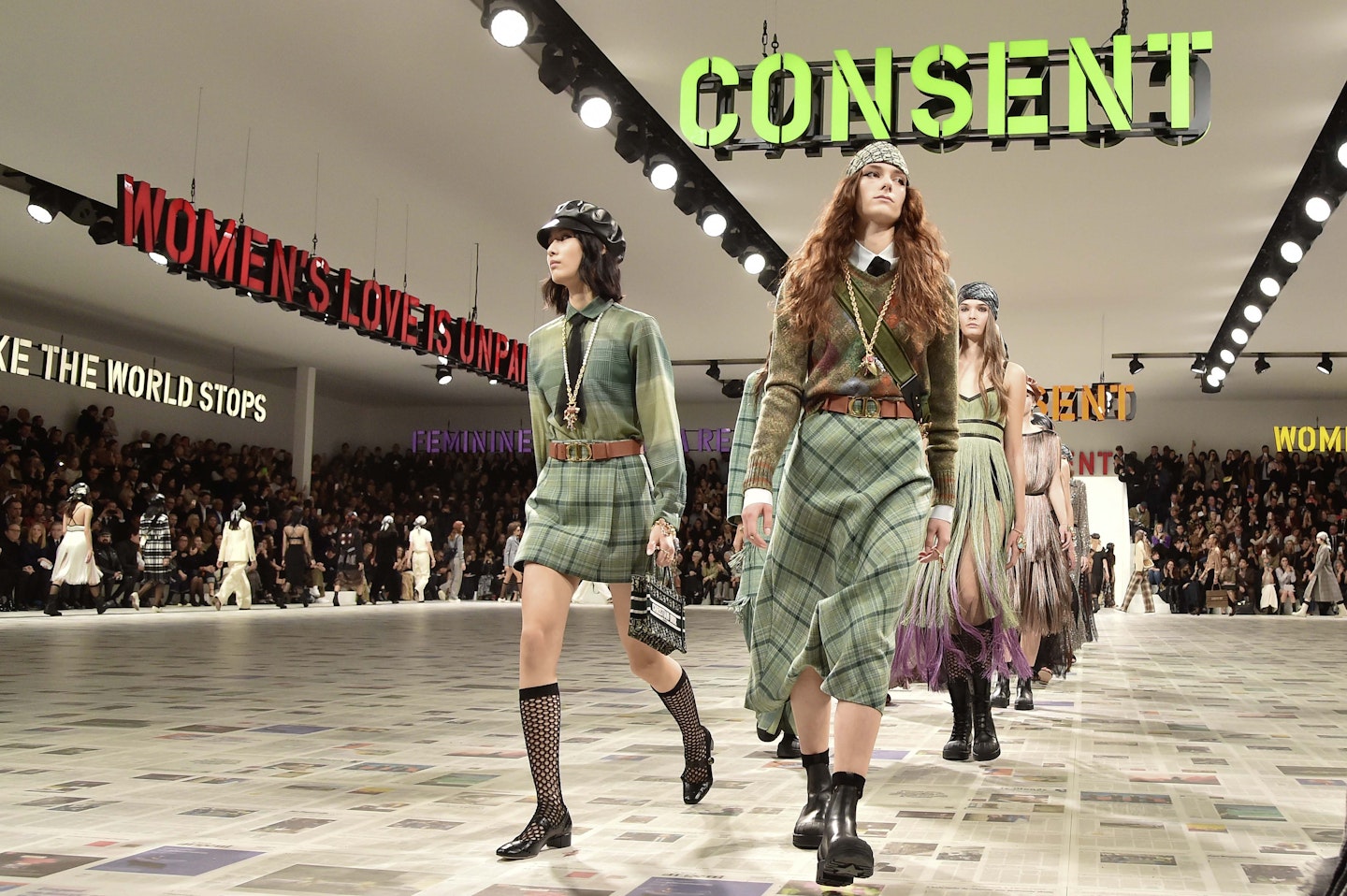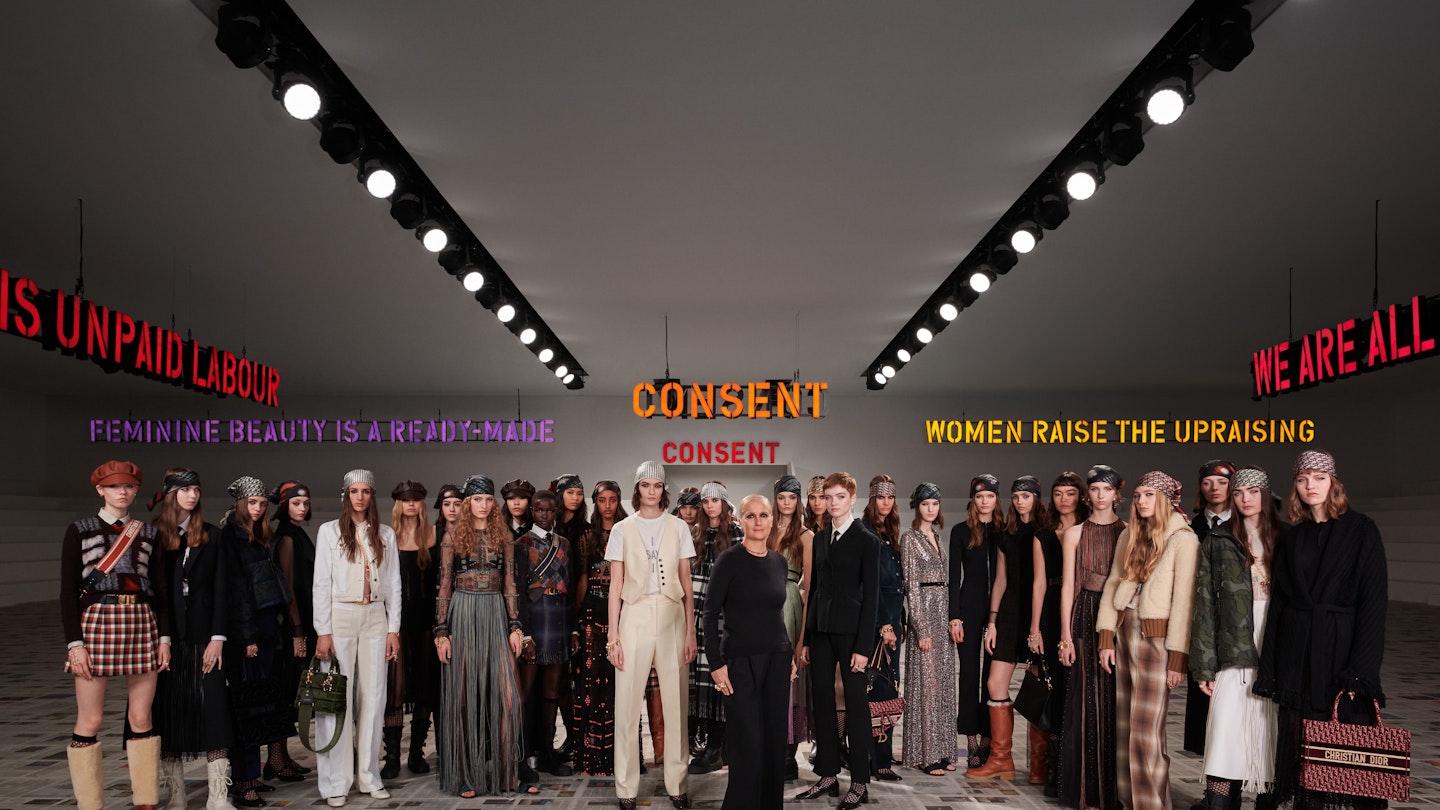Maria Grazia Chiuri is once again on the move after a very long pause. As we chat via Zoom she appears relaxed, dressed in a white T-shirt and Diorheadscarf, sitting outside the house that once belonged to her father in Puglia. The sun shines on her back and a sprawling row of what appears to my untrained eye to be unusually photogenic olive trees provides the most impressive Zoom backdrop I’ve seen during my lockdown experience so far. ‘My father was a farmer. I grew up in this area,’ she explains in her robust Roman accent.
Just days before, Maria Grazia was in Paris where she conducted a global press conference alongside CEO, Pietro Beccari, to announce plans for her Christian Dior Cruise collection, which will take place in Puglia this month. The following week, a trip back to France to reveal her new couture collection during the Fédération de la Haute Couture et de la Mode’s much-anticipated first ever digital show week.
And after that, her attention will turn to London for an upcoming pop-up store in Harrods, opening 1 August. It will be a lush, velvet-clad space offering shoppers in search of newness after quarantine the chance to buy updates on the brand’s old and new signatures, including its top-selling saddle bags and book totes and a new personalisation service. The wheels of fashion are slowly grinding again after months of lockdown, and so her life is too.

Fashion has always felt like a time warp, with its six months ahead of time show-to- retail cycle and three months ahead of time monthly fashion magazines. But that dizzying ‘what season is it again?’ feeling has increased tenfold, thanks to Covid-19, which swooped in and left us suspended mid-action – fashion cupboards full of clothing samples, factories heaving with yet-to-be-shipped orders and ad campaigns on the cusp of being shot – for months on end.
It feels like it’s been a lifetime since I saw Maria Grazia, back in February, at her big ticket, big budget autumn/winter ’20 show in Paris. That was roughly a week before she went into lockdown in Rome with her daughter Rachele Regini. (Her husband and son were in quarantine separately in their second home in Rome.)
Since then, everything – and, in some ways, not enough – has changed. ‘I think there is an important lesson from Covid that we have to reinvent ourselves every day,’ she says.
.jpg?auto=format&w=1440&q=80)
As far as re-entries go, Maria Grazia’s sounds as demanding as you would expect from the creative director of one of the luxury fashion world’s cornerstone brands. But listening to Maria Grazia describe it, her transition back into normal working life sounds more like a homecoming. Perhaps that’s because one of her first orders of business, the Cruise show, happens to be taking place in her father’s birthplace, a region she summered in as a young girl. ‘In this part of Italy everything is very familiar,’ she explains. ‘Fashion in Italy – I know everybody very well. Many companies are family companies. They are part, in some way, of my professional family. I call them for Christmas or holidays,’ she explains.
And while she began designing and planning the collection before coronavirus hit (it was originally scheduled to take place in May), the upcoming Cruise show has very much become a statement and a symbol of these Covid times. Maria Grazia wanted to support Italy, and specifically the Puglia region, which is on the verge of bankruptcy. ‘We would like to send a message of support, hope and rebirth to the world; to the big suppliers and the small ones. Many still don’t know how to survive, so this move is so important for the artisans that we need to preserve. We want to give them a reason to restart,’ Pietro Beccari said in the press conference.
One of the most striking aspects of Maria Grazia’s era at Dior is the socio-political messaging underpinning her clothes. She spent her first four years at the house using T-shirts, bar jackets, tulle skirts, tailoring and kitten heels to espouse feminism.

For example, she showed her A/W ’20 collection – held a day after Harvey Weinstein was found guilty of rape and sentenced to 23 years in jail – against a set of neon signs by the art collective Claire Fontaine, broadcasting #MeToo-adjacent messages in caps lock, such as, ‘CONSENT’ and ‘PATRIARCHY = CLIMATE EMERGENCY’. And there’s a mentorship programme, Women@Dior, dedicated to gender equality and sustainability. In recent years, she’s become more vocal about her growing awareness of climate change.
Today, it’s the economic fallout of coronavirus that’s on her mind. It runs a through line in four talks we have in seven days (our Zoom interview, a collection preview and two press conferences), in which she regularly mentions how many people depend on Dior for their livelihoods. ‘We give jobs to a lot of people,’ she says. The LVMH-owned house reported revenue of €53.7 billion in 2019. ‘And there are lots of people in the fashion system: journalists, photographers, make-up artists... I felt I had to do something.’
In the 1940s, Christian Dior, the man and the brand, played a part in lifting Europe out of a different sort of crisis. He showed his first collection in 1947, two years after World War II ended, eventually becoming a figure who helped a nation rehabilitate itself after one of the most devastating global conflicts in history. ‘[Christian Dior] wasn’t a revolutionary. He was a reactionary who reinvented national pride after a terrible moment,’ Florence Müller, a historian who helped curate the retrospective Dior: Couturier Of Dreams for Paris’s Musée des Arts Décoratifs told The Washington Post.
Maria Grazia seems acutely aware of her own responsibility in carrying on that legacy. ‘This is not a war, this is another kind of problem,’ she says. ‘And we have other problems now. It’s not like in the Second World War. Now there is the pandemic and this problem of [climate change]. It’s completely different. But, again, we give jobs to a lot of people. Sustainability means also to maintain jobs for the workers.’
.jpg?auto=format&w=1440&q=80)
For her couture collection, which she debuted with a big-budget film, Le Mythe Dior, directed by Matteo Garrone, of Gomorrah fame, Maria Grazia wanted to provide the other need Monsieur Dior met so famously during those post-war years in France: a bit of escapism. ‘In some ways we are so conscious about this time. We are so conscious about what’s happened – about all these problems. People need to dream. I need to dream,’ she says.
But even in the dreaming, you get the sense that Maria Grazia is ever aware of the news cycle. She’s the woman who popularised activism in fashion with a T-shirt (‘We Should All Be Feminists,’ a slogan taken from the speech by Chimamanda Ngozi Adichie.) This is not a woman who designs in a bubble. So it was unexpected in some respects to see her surprise when questioned about the near all- white casting of the film, in an interview that followed its premiere. Just hours before Dior debuted the mesmeric movie short – which featured nymphs and goddesses enchanted by doll-sized Dior gowns in the woods – Naomi Campbell had opened the week with a speech about the need for more meaningful diversity within the fashion industry in the wake of the Black Lives Matter movement.
‘For me, I think diversity is important but it depends on the situation and the reference,’ Maria Grazia said, explaining that the casting boiled down to the film’s Greek mythology references. ‘If I do another film, I probably make another casting. I don’t think it’s possible to make all the things with the same language even if I completely agree with the value.’
For context, she’s set previous shows in California (inspired by, among other things, a Georgia O’Keeffe exhibition) and Morocco (a celebration of Africa with a diasporic line-up of mostly Black creative collaborators). Fashion critics complained the Garrone-directed film was out of step with the cultural conversation defining the times. And that, as someone famous for being in tune with the zeitgeist, Maria Grazia had failed to read the room. For a woman so outspoken on social issues, it looked like she had missed an opportunity.
‘The strange thing is that I’m very sensitive to these issues, even before Covid,’ she told me when I asked her about Black Lives Matter and the growing social justice movement, a week before she debuted the film. ‘I’m very happy that we speak about these problems. But it is also evident that these problems have a long history. I can’t believe that only with this pandemic situation we start now to wake up,’ she said. ‘And I think a lot of people who were scared to use their voice start to use their voice. That is good. Sometimes people attack me to say, “You are a political designer.” Everybody is political. If you are human, you are political. Nobody is perfect, but we have to try to make something. I don’t think I can change the world, but I can do a little part. If everybody thinks they can do a little part all together, probably we can create a better place to live.’
